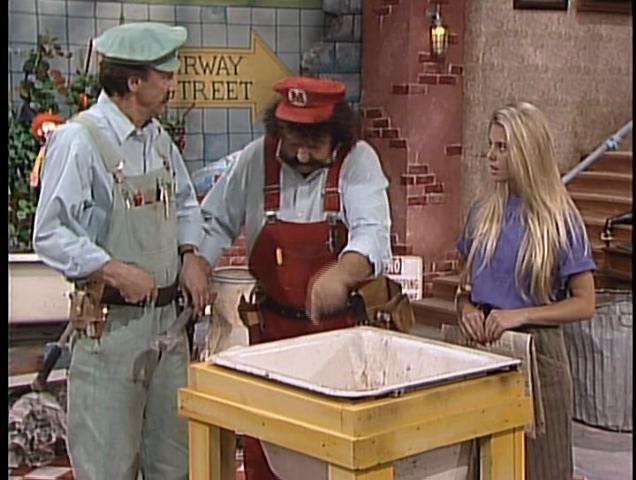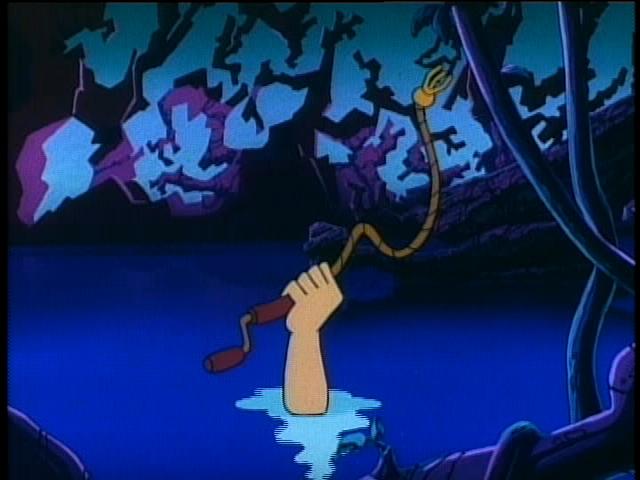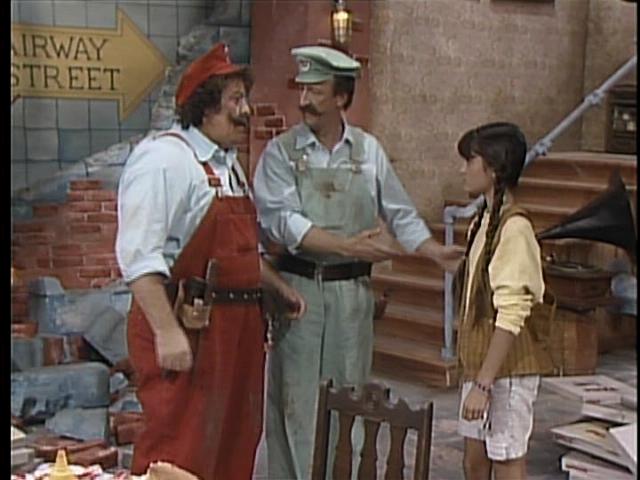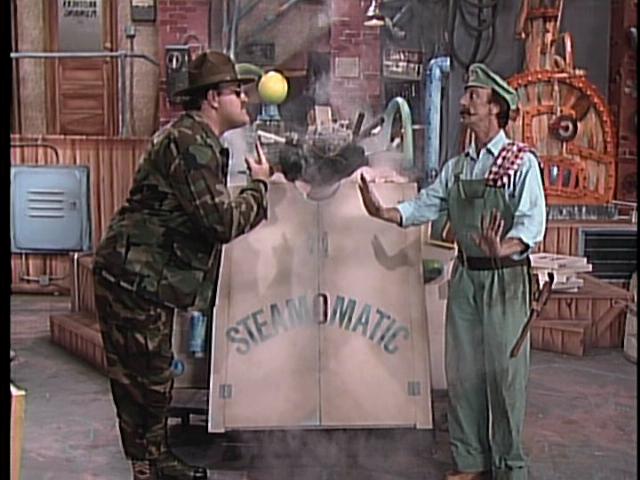Give Me Pasta Power as Fast as You Can (original) (raw)
Okay, nobody at all expressed interest in my reviewing individual Super Mario Bros. Super Show episodes, but I felt like doing it anyway, so here are thoughts on the first four. Each one has both a cartoon and a live-action segment, with the latter much shorter and presented on either side of the animated part. I’m going to go with the cartoon first and then the live action for each episode.

The Bird! The Bird! – Is that title a reference to anything? Maybe to “Surfin’ Bird,” which they originally played in the episode, but it was cut for copyright reasons on later airings and the DVDs? They replace the cover songs from action or chase sequences with instrumental versions of songs from The Adventures of Super Mario Bros. 3, and it rarely seems to fit the mood. The first episode is a little different from most of the others in that, while King Koopa is there and sending his troops against Mario and company, he doesn’t really have a scheme going on. The opening narration has it that Mario and Luigi had rescued the Princess from Koopa, and were making their way through the Land of Ice trying to find magic that would drive him away and free her people. Does this take place immediately after the opening sequence, or after the events of the first game? Do the games even count in this continuity? Has Super Mario Bros. 2 occurred, and if so, is anyone surprised that the creatures from Mario’s dream are showing up as Koopa’s henchmen? The main plot involves a nearsighted Birdo who mistakes Toad for her lost chick. This Birdo can fly and lives in a nest, so is more bird-like than the ones in the games. There’s also no reference to the transsexual thing from the instructions, as I guess makes sense; she’s just female. Her idea of a flying lesson is just dropping Toad while high up in the air, so maybe it’s no particular surprise her baby was lost. Toad uses his cap as a parachute, and while he takes the cap off a few times in the cartoons, I have no idea how he got it to inflate.
Meanwhile, Mario, Luigi, and the Princess are spotted by two Flurries, who report it to Koopa; and he sends out troops to attack. We also learn that he likes his feet licked, one of several weird foot references with the character throughout the series. There was actually a page that documented a bunch of them, but I don’t know if it’s still up. When the heroes come across a Fire Flower, the Princess explains to Mario what it is; but when he touches it and gains its power, he says, “I love when that happens.” So is she really just explaining to the audience or what? Mario uses fireballs to melt ice and snow before he does that in a game; I believe SMB3 is the first where he can. Luigi’s awkwardness is emphasized. He struggles to keep his footing after making a long jump, perhaps a reference to how he controls more awkwardly in games where he moves differently from Mario, and uses a lot of malapropisms, like “They got us surrendered!” Mario saves the actual baby Birdo, and Toad, who arrives conveniently nearby after his parachute drop, returns him to his mother. The Birdo then helps drive off Koopa and his forces with vegetables, and invites the gang to her nest for dinner, which turns out to be worms.

Neatness Counts – The live-action bit has Nicole Eggert, the first guest star (she was on Charles in Charge and Baywatch, not that I ever watched either of those), show up in the Mario Brothers’ medicine cabinet for some reason. The Marios want to show how good they are at unclogging drains, and just happen to have a stopped-up sink sitting around. That’s a common thing in this show that doesn’t make any sense but is pretty much required due to the fact that the segments are limited to one set. You wouldn’t normally take a sink or toilet out of your home and take it to the plumbing shop, would you? Anyway, the sink sprays Nicole in the face, and then she steps on a cake that’s just lying around, and gets sneezed on by the somewhat anthropomorphized furnace. It’s okay, though, as she’s attending a sloppy party. Now, I don’t think that’s a thing, but if it were, I’d think guests would show up in messy-looking outfits, not covered in actual filth. But then, I’m not the one who made it up. I suppose I should also acknowledge the rumor that Mario says, “Fuck you, Luigi!” near the beginning. He obviously doesn’t, but the poor sound quality and the constant sound effects don’t help to dispel the rumor.

King Mario of Cramalot – In a very loose King Arthur parody, the gang arrives in Cramalot, a typical sort of name for this show. There’s no real joke in it; it’s not like the people there are all squished together or have to constantly study for exams. It’s just a silly-sounding take on the original name. Their reason for going there is to seek help from the wizard Mervin, who informs them that Koopa took over Cramalot after the previous king died. That’s more explanation than we generally get in these situations. The wizard tells Mario that whoever pulls the Golden Plunger from the Sacred Sink is destined to save the country and become king, and Mario succeeds. The Plunger seems to have magic powers, as Mario uses it to break out of a net. Koopa shows up and takes it, and locks everyone in a dungeon. Mervin arrives after having to buy batteries for his wand, and transports them to the Forest of Perpetual Night and Terrible Dangers, where a hand from the water throws Mario Excalibur, which is a plumber’s snake in this world.
At least it’s not Excalipoor.
It gives him the Super Mario color change, although he doesn’t shoot fireballs. While Mario duels with Bowser, the others fight off the Koopa Troopas, who become immobile when stomped or hit but don’t go inside their shells. Speaking of weird stylistic choices, there’s a particularly lazy bit of animation toward the beginning of the episode, where the characters jump over some Beezos, and then just remain suspended in midair. And when Mario tries to get Luigi to swim across the moat, his excuse is “I can’t! I’m having a baby!” After getting scared by some Trouters (which seem to be a combination of those and the more proactive Cheep-Cheeps; Trouters in SMB2 don’t really do anything other than jump up and down), he runs in the air above the moat, typical cartoon physics but poor video game physics. Those things can overlap, and obviously neither one has to be realistic. In many games, Mario can jump higher than any normal person, change direction in the air, fall from a great height without being hurt, and breathe indefinitely underwater; but there are still a lot of cartoon clichés that don’t apply. The show is inconsistent in what the rules are, which is probably to be expected, but still bothers me sometimes. After the team trashes the Troopas, Koopa throws a bottle of magic potion and first uses the line, “He who koops and runs away lives to koop another day!”, then goes through the door that disappears behind him, something he’ll do multiple times throughout the series. He does this pretty slowly, but no one ever tries to stop him. Where the doors lead is never shown. Mervin offers to let Mario stay on as king, but insists that the king has to be in shape, so Mario gives up the crown and runs away. One question is, if the original intention was to ask Mervin for help restoring the Mushroom Kingdom, why doesn’t anyone ask him? Instead, they help him and then leave. The games would eventually have their own version of Merlin with Merlon and his compatriots.

Day of the Orphan – Danica McKellar, who played Winnie Cooper on The Wonder Years, shows up at the Mario Brothers’ place identifying herself as Patty the Sad-Eyed Orphan and manipulates the plumbers into letting her hang around and setting up a birthday party for her. As they finish preparing, Patty’s parents show up at the door, and they’re obviously mad, but agree to stay for the party. It is kind of weird that a girl who ran away from home would head for a basement plumbing shop, but that sort of thing happens all the time in this show.

Butch Mario and the Luigi Kid – I had this one on VHS, so I’ve seen it quite a few times, and with the cover song (the theme from “Rawhide”) still intact. I haven’t seen Butch Cassidy and the Sundance Kid, but this still seems like a pretty loose parody. Mario and Luigi don’t become train robbers, for instance. From the plot description on Wikipedia, it looks like the main similarities are that they’re on the run from the law in the Old West, and a mine, explosives, and a shootout are involved in some way. Koopa has already captured the Princess and imprisoned her in a mine shaft, seemingly trying to starve her into submission. When Mario and Luigi arrive, they find out that they’re wanted outlaws, due to Koopa having taken over a nearby town and made Mouser the sheriff. Toad is there too, but apparently Koopa didn’t bother to offer a reward for him. The SMB2 boss shows up quite a bit as Koopa’s right-hand rodent, and talks with a German (or, according to some sources, Swiss) accent.
There are a lot of SMB2 elements incorporated into this version of the Wild West. The first wanted poster is found on a Pokey who wants to turn in the brothers until Mario throws a plunger in his face, Ostros are used in place of horses, and Cobrats (and in one case a Piranha Plant, before Piranha Plants that could spit fire appeared in a game) function as guns. When the gang first runs into Sheriff Mouser, they escape by jumping across a waterfall on logs. He sends his posse of Snifits after them, but they immediately go over the falls. Mario and company see some humorously specific smoke signals from the Princess and follow them to the mine, only to run away when Mouser sends a boulder toward them. They come to town and enter a building offering free Italian food, only for it to actually be the sheriff’s office where Koopa is waiting for them. This kind of trick occurs pretty often, and always seems to work on Mario. The three would-be rescuers are locked up, but Toad manages to sneak out in Mouser’s hat, which he somehow doesn’t notice has gotten heavier. Toad uses some Bob-ombs from the nearby saloon to bust out Mario and Luigi, who briefly have a cartoon blown-up look, but quickly return to normal. He bombs the saloon as well, but since Mouser was in there and he’s fine in the next scene, I guess these are the sort of bombs that destroy buildings but leave people standing. Going back to the mine, there’s a showdown between Koopa and Mario, although neither of them hit anything with their weapons because it’s a kids’ show. Well, I say that, but we never find out if the Snifits who went over the waterfall survived. Our heroes go into the mine to rescue the Princess, only to end up trapped in the shaft with her. Conveniently, there are pipes down there, so Mario and Luigi are able to use them to escape and wash away the bad guys.

All Steamed Up – Captain Lou was presumably able to use his wrestling connections to bring in a few pro wrestlers as guests, in this case Sergeant Slaughter in one of two appearances. Mario and Luigi are fixing his steam cabinet, which, like the sink in the first live-action segment, is inside their apartment, even though that doesn’t make sense. At least the Sergeant has a tank to put it on, which he claims he double-parked on top of a Chevy. Mario decides to try out the cabinet and gets trapped inside, while Slaughter forces Luigi to talk in military cadence and do 500 push-ups. When Mario finally gets out, he’s shrunk, and in this case not because an enemy ran into him.

Mario’s Magic Carpet – While it makes sense that they’d do an Arabian Nights themed episode, what with those themes appearing in SMB2, but I have to say that this one makes even less sense than usual. The gang is traveling through the desert with a camel in search of Aladdin’s lamp, and I have to say it’s a little strange that they just use the name Aladdin instead of a goofy parody. Since they’re cartoon characters in a desert, they’re basically required by law to see wacky mirages, and they do. They finally see a swimming pool that does appear to be physically there, only it turns out to be a trampoline. I guess I’ll give them the benefit of the doubt because they’re dying of thirst, but the fact that there were no ripples and no depth should have clued them in. Then again, when the animation is lazy anyway, it’s hard to tell what’s on purpose and what isn’t. They all fall into a castle with a flip-top roof, even though it’s unlikely they all would have ended up springing the same distance in the same direction. Then again, I guess springing platforms in the games sometimes work like that. The castle belongs to Sultan Pasbah, a nasty Middle Eastern stereotype voiced by a white guy, who keeps the Princess in his harem and the others in the slave quarters. They’re able to sneak out at night, and Mario is able to take the lamp they’re looking for (nice coincidence, that) by cutting the glass around it with a pizza cutter. You’d think there would be some sort of security set up, but whatever. As they go to summon the genie, the Sultan announces that he’s planning on selling the Princess, and Koopa soon shows up to buy her. He took a little longer to show up than usual, and I’m not sure how he heard that the Princess was for sale. Pasbah does mention putting out a classified ad, but it’s still the same night, so I guess it’s just the good and bad guys happening to visit the same country at the same time again. The genie turns out to be an annoying woman who nags everybody with a New York accent (there must be more of a link between Mario and Luigi’s old home and the Mushroom Kingdom, as even Toad has a Brooklyn accent), and her magic never works the way it’s supposed to. Maybe the Sultan was aware of this, and that’s why he didn’t bother to keep the lamp guarded; but I’m sure I’m thinking about this more than the writers did. I found it odd how she was creeped out by Toad, but gasped with everyone else when Koopa was mentioned. How much news was she privy to while inside the lamp? She tries to make a magic spell but instead makes a magic smell, distracting the Sultan and allowing Koopa to make off with the Princess without paying. And that’s the last we see of Pasbah in the episode. Koopa makes a getaway on a flying carpet with a car built into it, certainly different from the ones in SMB2.
When the genie is unable to do anything to help Mario, Luigi, and Toad chase Koopa, they go to a used carpet lot. We don’t see them there, but there are plenty of scenes of the Marios haggling with sleazy salesmen later on in the show, so I guess we didn’t need one more. We see them on a rather rickety car-carpet, and we find out that Koopa’s evil plan is to dump the Princess in some quicksand. I thought he wanted to force her to surrender her kingdom, not kill her. While this isn’t the only episode where that’s the case, it’s part of why I find this one sloppy. If the Sultan hadn’t been distracted by the foul odor, would he have paid for the Princess and then just dumped her in the sand? Seems like he didn’t really think this out. The heroes do manage to save her, thanks partially to how the sand isn’t really that quick after all, but Koopa uses his carpet phone to call in some Pidgits, who for some reason eat carpets instead of riding on them. Luigi somehow knows their language, which consists simply of the word “Pidgit,” and he convinces them Koopa’s carpet is tastier.
The genie also decides to go bother Koopa instead. As terribly plotted as this one is, we are actually shown how useless the magic they’re looking for at the beginning is, so it doesn’t leave the unresolved question we had with Mervin of why they never even asked him to help liberate the Mushroom Kingdom. Obviously the genie wouldn’t have been able to help. On the other hand, they still have the carpet at the end of the episode, and there’s no indication that they go back for the camel.

Marianne and Luigeena – In the first instance of Albano and Wells cross-dressing, they play Mario and Luigi’s female cousins, who show up when the brothers are out and football player Lyle Alzado is visiting. They shamelessly flirt with him, but leave when they see Mel Gibson in the area. I guess it wasn’t as well known how he treated women back then.
